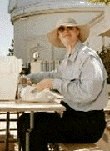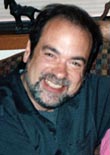|
|
This topic comprises 2 pages: 1 2
|
|
Author
|
Topic: Early Widescreen
|
James Layton
Film Handler
Posts: 3
From: Norwich, Norfolk, UK
Registered: Nov 2007
|
 posted 12-11-2007 12:42 PM
posted 12-11-2007 12:42 PM





In the late 20s and early 30s several films were produced in large format widescreen; processes such as Fox Grandeur, Realife, Vitascope, Natural Vision & Magnifilm - all rival formats from different studios.
Does anyone know what has survived of these films and in what condition? I would imagine that for most of these we only have 35mm copies if that. I know there have been restorations of 'The Big Trail' and 'The Bat Whispers', but are there 70mm prints available for modern theatrical projection or just 35mm anamorphic? Also I believe there is a 35mm print of some Fox Grandeur News which has been shown at the Widescreen Festival in Hollywood, I'm not sure where though.
Here is a short list of many of these early large format films. Does anyone know if elements of any type for these films still exist? I'm very interested to know and are there any modern prints of the widescreen versions of these films in 70mm or 35mm?
Natural Vision
The American (J. Stuart Blackton, 1927, Natural Vision Pictures)
Danger Lights (George B. Seitz, 1930, RKO)
Niagra Falls
Campus Sweethearts (James Leo Meehan, 1930, RKO) short
Fox Grandeur
Fox Movietone Follies of 1929 (David Butler, 1929, Fox Film Corporation)
Fox Grandeur News (1929)
Happy Days (Benjamin Stoloff, 1929, Fox Film Corporation)
The Big Trail (Raoul Walsh, 2 October 1930, Fox Film Corporation)
Song O' My Heart (Frank Borzage, 1930, Fox Film Corporation)
Vitascope
A Soldier's Plaything (Micheal Curtiz, 1930, Warner Bros. Pictures)
The Lash (1930, First National Pictures)
Kismet (John Francis Dillon, 1930, First National Pictures)
Larry Ceballos Review (short)
You're in the Army Now (short)
Realife
Billy the Kid (King Vidor, 1930, MGM)
The Great Meadow (Charles Brabin, 1931, MGM)
Magnifilm
The Bat Whispers (Roland West, 1930, Joseph M. Schenck Productions/United Artists)
| IP: Logged
|
|
Stephen Furley
Film God

Posts: 3059
From: Coulsdon, Croydon, England
Registered: May 2002
|
 posted 12-11-2007 01:06 PM
posted 12-11-2007 01:06 PM




'The Big Trail' is the only one I have seen. It was restored some years ago on 35mm amamorphic from original 70mm elements. The picture quality was variable, in some parts it looked very good. The sound quality, from the original optical track, was pretty poor; I've heard better from normal 35mm tracks of that era. It's worth seeing, if you get the chance. It does turn up very occasionally at the NFT.
Given that the restoration was done using modern fine grain duplicating and print stocks, as against 1920s camera stocks I doubt that much, if anything, was lost by doing it in 35mm.
There was also a NTSC VHS release of this, but most of this was just 3:4. I'm not sure if it was just cropped down from 1:2, or if it was taken from the 35mm version of the film.
| IP: Logged
|
|
|
|
|
|
|
|
Stephen Furley
Film God

Posts: 3059
From: Coulsdon, Croydon, England
Registered: May 2002
|
 posted 12-12-2007 08:02 AM
posted 12-12-2007 08:02 AM




quote:
As with the silent and sound versions of Blackmail, the wide and square Big Trails have a very different look and feel to them. A DVD containing both versions, plus a decent 'making of' with a widescreen historian like John Belton involved would be a great project.
It would indeed, but I don't know how well it would sell, or how many copies it would need to sell to make such a project viable. For some reason there seems to be much less interest in the formats of this era than in those of the '50s, despite the fact that where was only 25 years or so between them, and therefore the '50s formats are now about two-thirds the age of the earlier ones.
quote: Leo Enticknap
Incidentally, the Mitchell camera used for Grandeur was almost identical to the one later used for Todd-AO: the only real difference was better lenses, and converting it from a four-perf to a five-perf pulldown.
It might be worth pointing out, for the sake of avoiding confusion if somebody is not familiar with the Grandeur format that four perfs of Grandeur is not equal to four perfs of normal film; the size, shape, position and pitch of the perfs is totally different. A four-perf Grandeur frame is almost the same height as a five-perf Todd-AO one; it's actually just a few thousanths of an inch less, but the width is considerably less, to give a 2:1 aspect ratio. The Grandeur track is much wider than a normal 35mm one, and obviously runs faster due to the greater frame height, but is otherwise a normal variable density mono optical track.
| IP: Logged
|
|
Leo Enticknap
Film God

Posts: 7474
From: Loma Linda, CA
Registered: Jul 2000
|
 posted 12-12-2007 02:22 PM
posted 12-12-2007 02:22 PM





James - your info says you're from Norwich. Just out of curiosity, are you a UEA film archiving student, possibly thinking about early widescreen as a dissertation topic? If so, this sounds like a great idea. Belton covers the factual basics very well, but a study that looks at the late 20s/early 30s special formats specifically, and tries to come to some conclusions about why they didn't achieve mass rollout and therefore the extent of their cultural significance is something that needs doing, IMHO.
You might like to see what MIC can offer in terms of preservation status data, as it's a portal site that includes cataloguing records from most (but not all) of the world's major public archives. It doesn't cover most of the studio collections, though. If you have a focused enquiry and are prepared to include the reason for it, you could also try a post on the Association of Moving Image Archivists email listserv.
quote: Stephen Furley
It would indeed, but I don't know how well it would sell, or how many copies it would need to sell to make such a project viable. For some reason there seems to be much less interest in the formats of this era than in those of the '50s, despite the fact that where was only 25 years or so between them, and therefore the '50s formats are now about two-thirds the age of the earlier ones.
It could possibly be because very little source material survives in the form that is needed for the basis of a restoration to something approximating (or at least simulating) the original format; or also because there's been very little research in this area. Agreed that DVD production costs are not cheap, but niche market publishers like Criterion and Milestone seem to be able to make similar sorts of projects viable.
| IP: Logged
|
|
|
|
|
|
|
|
|
|
Leo Enticknap
Film God

Posts: 7474
From: Loma Linda, CA
Registered: Jul 2000
|
 posted 12-13-2007 01:18 PM
posted 12-13-2007 01:18 PM





quote: James Layton
Leo, I work at EAFA in Norwich and am one half of the CRITICAL FLICKER film group. I believe you know of us already.
Sure do! Sorry to hear (via Louise) that you've been having venue problems, and hope you manage to get your screenings up and running again soon.
quote: James Layton
THE BIG TRAIL was restored in its 70mm Grandeur version by 20th Century Fox and MoMA, and the 35mm scope print available from MoMA is a reduction print from this restoration. I'm not sure when the restoration was done - mid-90s I believe. This copy is still available providing your facilities meet their standards. A 70mm print of the film was shown at The Widescreen Weekend at the Bradford Film Festival in 1995 as a 'one-off never to be screened again' deal.
And what's the friggin' point of going to all the expense of striking a 70mm print if, after one outing, it's 'never to be screened again'?! Grrr! Mieow! Hiss! Gives the whole film archive movement a bad name. I suppose the silver lining is that there's also a 35mm 'scope copy in the BFI's '360 classic films' print collection. I've seen it a couple of times and it looks good, but even the most faultless scope presentation introduces a bit of anamorphic aberration towards the edges.
Does anyone know if any attempt has been made to recreate a Magnascope show - Chang or Wings, for example? Given that the system consisted basically of a zoom lens, a screen masking system that opened up on all four sides plus a lot of ballyhoo, it shouldn't be too difficult to recreate. It'd look fantastic in an Imax house!
| IP: Logged
|
|
|
|
|
|
Dan Sherlock
Film Handler
Posts: 11
From: Hollywood, CA, USA
Registered: Feb 2008
|
 posted 02-12-2008 09:01 PM
posted 02-12-2008 09:01 PM




I saw the Grandeur short subject "Hudson River Bridge" at a special presentation (open to the public) on May 22, 1999 at American Cinematheque's Egyptian theater in Hollywood. It was a 35mm 'scope copy made from the 70mm Grandeur version. I don't have the exact running time, but it was about 10 minutes or so. Except for it's technical significance, it was amazingly dull -- I think they shot entire film loads of guys feeding steel cables off of a very large spool. There was nothing even resembling a bridge in the footage. I believe there was no narration -- just the sounds of construction.
The film was originally shown with the feature film LET'S GO PLACES in New York around March 1, 1930. (I don't have the exact premiere date, but it is within a day or two of this.) The feature was not shown in Grandeur.
According to the notes distributed at the American Cinematheque showing, here is the info about that screening:
"Our thanks to the Museum of Modern Art for providing the print for Hudson River Bridge. Rights for this showing granted by Criterion Pictures, with permission granted by the UCLA Film Archive. Assistance in locating the film materials was supplied by Kathleen Henchman, Film Technology, Inc."
Now I suppose you would like to know how this 'scope copy came to be. According to the article "Preserving Wide Film History" by Grant Lobban in the April 1985 issue of The BKSTS Journal, Karl Malkames Inc. in New York developed a special variable-pitch printer movement that was used in combination with a 'scope printer lens to create an anamorphic 35mm copy of THE BIG TRAIL. An example frame from the original FOX GRANDEUR NEWS was also shown in the article, so it is very likely that he also did the conversion of HUDSON RIVER BRIDGE. Grandeur was originally 20 fps, but this was released about the time Fox changed to 24 fps, and I believe this title was at 24 fps.
THE BIG TRAIL was shown on the cable network Turner Classic Movies in both the regular 35mm version and the widescreen Grandeur version. Unfortunately only the regular version was released on DVD. My memory of watching the two versions is that many of the scenes were shot with both types of cameras at the same time. In some cases, the two cameras were many feet apart aimed in different directions with totally different framing. I have also seen the 'scope print in a theater, and the distorted sound quality is present in all showings that I have seen.
I am not aware of any other Grandeur titles being preserved, but it is possible that the NIAGARA FALLS short (not on your list) as well as possible other newsreels might exist. (The NIAGARA FALLS short that was shown with HAPPY DAYS was a different format and different footage than the NIAGARA FALLS short in Natural Vision shown with DANGER LIGHTS.) I don't believe that SONG O' MY HEART was released in Grandeur.
THE BAT WHISPERS was preserved by direct printing from the 65mm original to a 65mm preservation element. That element was then re-centered (the image was offset from center to allow for an optical sound track) and optically printed to a 'scope master which was the source for the theater prints for screenings of the restored version. The restoration was done primarily by Bob Gitt who was with the UCLA film archive. I highly question the report of a one-off showing of a 70mm print as reported on film-tech. Both the regular and Magnifilm versions are on the DVD. THE BAT WHISPERS was printed down to 35mm maintaining the original aspect ratio within the silent aperture area and shown with interlocked sound.
I have found no convincing evidence that BILLY THE KID or THE GREAT MEADOW were released using 70mm prints. Instead, 35mm reduction prints with a 1.75:1 aspect ratio were used. So it is possible these might exist, but to the best of my knowledge their whereabouts are unknown.
The 56mm Paramount Magnafilm short subject YOU"RE IN THE ARMY NOW was mixed into the Warner Bros. 65mm Vitascope listings in the initial posting in this thread. I've seen many different frames from this title in publications over the years, which makes me think that the original is lurking about, but I am pretty sure it has not been converted into a conventional format. The existence of the frame samples is surprising considering it was apparently only shown once at a demonstration screening.
The Vitascope titles status are also unknown, but I strongly suspect they are lost. They are certainly not available for screenings. And the LARRY CEBALLOS REVIEW footage was used as part of a live show in Hollywood that only ran for about a week, so it is VERY unlikely that it survives.
And then there's Natural Vision. THE AMERCIAN was indeed filmed in Natural Vision, but it was never released that way. CAMPUS SWEETHEARTS was rumored to have been filmed in Natural Vision, but it certainly wasn't released that way, and I can't find a reliable confirmation that it was even filmed in Natural Vision. There WAS a copyright filed on the 35mm version. There was some footage of the first act of the Broadway musical LADY FINGERS shot in Natural Vision and shown that way at a demo, but it was apparently not shown to the public.
NIAGARA FALLS and DANGER LIGHTS were shown in Detroit and New York (at least), and I've seen frame samples from them, but only from publications at the time. Reports are that the 35mm negative of DANGER LIGHTS was deteriorating back in the 1950's, and it was transferred to safety stock before the negative was destroyed. No word on what happened to NIAGARA FALLS.
The 35mm version of DANGER LIGHTS is available for download as an MPEG file from:
http://www.archive.org/details/danger_lights
It is also scheduled to be shown on Turner Classic Movies on the 16th of April, 2008.
Supposedly George Spoor also showed some Natural Vision footage at the Chicago World's Fair around 1932, but I have been unable to confirm this.
So, the bottom line on what can be screened right now from the 1930's widescreen boom:
THE BAT WHISPERS (in 'scope 35mm)
THE BIG TRAIL (in 'scope 35mm)
HUDSON RIVER BRIDGE (in 'scope 35mm)
and possibly Fox Grandeur News (in 'scope 35mm, but probably at 20 fps).
-Dan
| IP: Logged
|
|
|
|
All times are Central (GMT -6:00)
|
This topic comprises 2 pages: 1 2
|
Powered by Infopop Corporation
UBB.classicTM
6.3.1.2
The Film-Tech Forums are designed for various members related to the cinema industry to express their opinions, viewpoints and testimonials on various products, services and events based upon speculation, personal knowledge and factual information through use, therefore all views represented here allow no liability upon the publishers of this web site and the owners of said views assume no liability for any ill will resulting from these postings. The posts made here are for educational as well as entertainment purposes and as such anyone viewing this portion of the website must accept these views as statements of the author of that opinion
and agrees to release the authors from any and all liability.
|

 Home
Home
 Products
Products
 Store
Store
 Forum
Forum
 Warehouse
Warehouse
 Contact Us
Contact Us




 Printer-friendly view of this topic
Printer-friendly view of this topic















